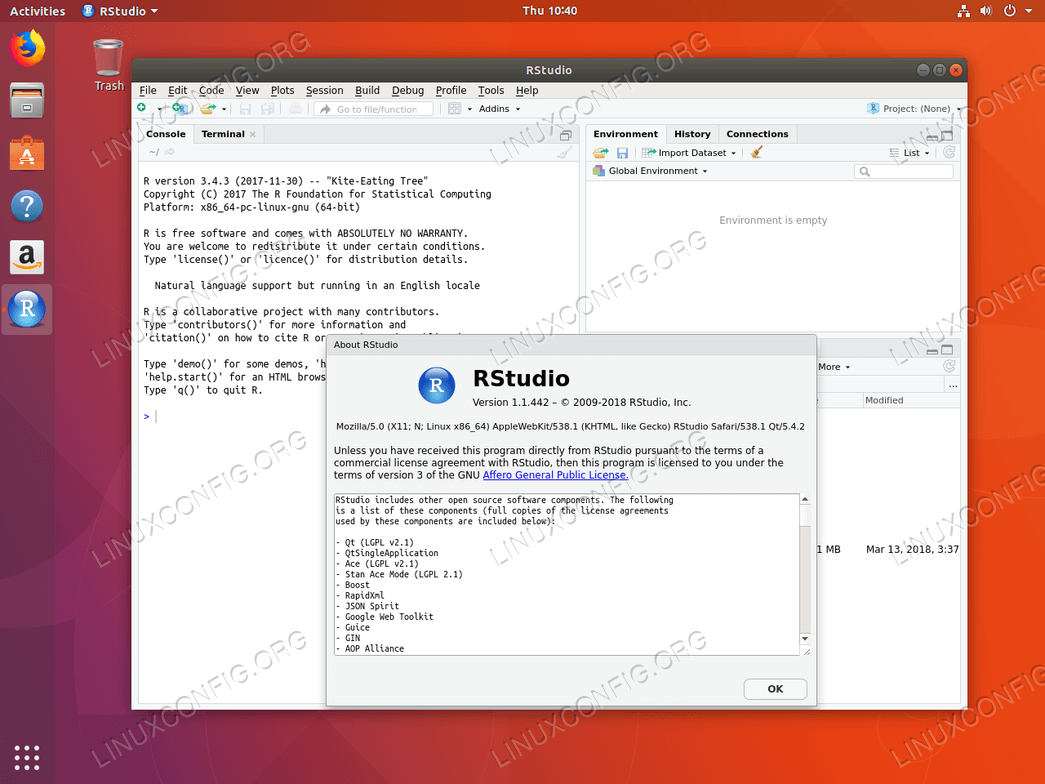
- #INSTALL RSTUDIO LINUX HOW TO#
- #INSTALL RSTUDIO LINUX INSTALL#
- #INSTALL RSTUDIO LINUX UPDATE#
- #INSTALL RSTUDIO LINUX DOWNLOAD#
#INSTALL RSTUDIO LINUX INSTALL#
To easily install Rstudio Desktop or Server, we will use the Gdebi Package manager that will automatically fetch and install the required dependencies needed by the tool.
#INSTALL RSTUDIO LINUX UPDATE#
To flush the cache and let the system rebuild a new one, run the update command: sudo apt update Install Gdebi sudo add-apt-repository "deb focal-cran40/" Run update
#INSTALL RSTUDIO LINUX DOWNLOAD#
Next, to download the R packages, define its source by adding the repo URL. sudo apt-key adv -keyserver -recv-keys E298A3A825C0D65DFD57CBB651716619E084DAB9 Add R-base repository Therefore, to make sure the packages we are getting are from the original source, the system needs the GPG key issued by the developer. Note: I wrote this blog post through R Studio (via blogdown) on my Chromebook! CC BY-SA 4.On Ubuntu 20.04, we would not be able to install R-base using the official repository source, at least while performing the tutorial I couldn’t thus, here we are going to install it by adding its repo. I am compelled by the idea of not only browsers (i.e., R Studio Cloud is pretty amazing and made it easier for 7th-graders to use R), but also operating systems, being able to more flexibly run a variety of applications, especially for learners, and particularly for learners to be able to do more with existing technology. Being able to install R and R Studio is useful (to me), but I am sure that being able to install other applications may be more useful. To what end? Chromebooks can be less expensive than (Mac or Windows) computers, and their operating system can be easy to use, although Chromebooks are limited by their inability to install other applications. That was remedied by running the following (thanks to this forum answer): sudo apt-get install r-base-dev xml2 libxml2-dev libssl-dev libcurl4-openssl-dev unixodbc-dev One addition: When I tried to install the tidyverse package, I ran into an issue with httr and rvest. You’ll have to keep your Linux terminal/the command line interface open while running RStudio. Now, type rstudio in the command line interface: rstudioĪmazingly (to me), the R Studio application should open on your Chromebook - and be pretty snappy (so far, the functionality seems comparable to that on my Chromebook, including the ability to use git/GitHub - though that has more to do with Linux, I think, than R Studio)! I also had to run the following, to install another shared library (h/t to this forum answer): sudo apt install libnss3 The tutorial notes that one shared library has to be installed, before you can run R Studio: sudo apt-get install libxslt1-dev rstudio-, and then press tab, it should auto-complete the name): sudo gdebi rstudio-xenial-1.1.b Then, install the R Studio file downloaded (if you start typing the name of the file, i.e.

Run the following command, which installs a tool that will be used to install the R Studio file that was just downloaded: sudo apt-get install gdebi-core Save it to the Linux partition, which is helpfully available/viewable directly in the file viewer for Chromebook. Install R Studioįirst, download the Debian 9+ version of R Studio from R Studio’s website. You should see some text and then what looks like (and is) an R Console. Run the following to check that R installed: R Install R sudo apt-get install r-base r-base-dev

In short, here are the steps I followed that worked, with one from (and one addition to) the above tutorial mentioned.
#INSTALL RSTUDIO LINUX HOW TO#
I then found this super helpful tutorial for how to install R Studio (as well as R), and followed it, and found it worked, with a few exceptions. At this point, I was a little flummoxed by what to do, and so I searched Google, and saw that it is possible to install Linux programs, like Python or R, directly from the command line interface. That showed something, namely, my Google user name perhaps there could be different directories for every screen name. I then ran the following, to see if there was anything “one level up”” in the file structure: cd. There are a few things I know how to do through a command line interface one is to list all of the files and directories available, so I ran the following: ls After doing it (it took a few minutes to download Linux, but was otherwise super straightforward), I opened up the command line interface and saw this:

I’ve had a Pixel Slate Chromebook for a little while, and noticed in a recent update that it was possible to install Linux.

Using R/R Studio from a (Pixel Slate) Chromebook 0


 0 kommentar(er)
0 kommentar(er)
